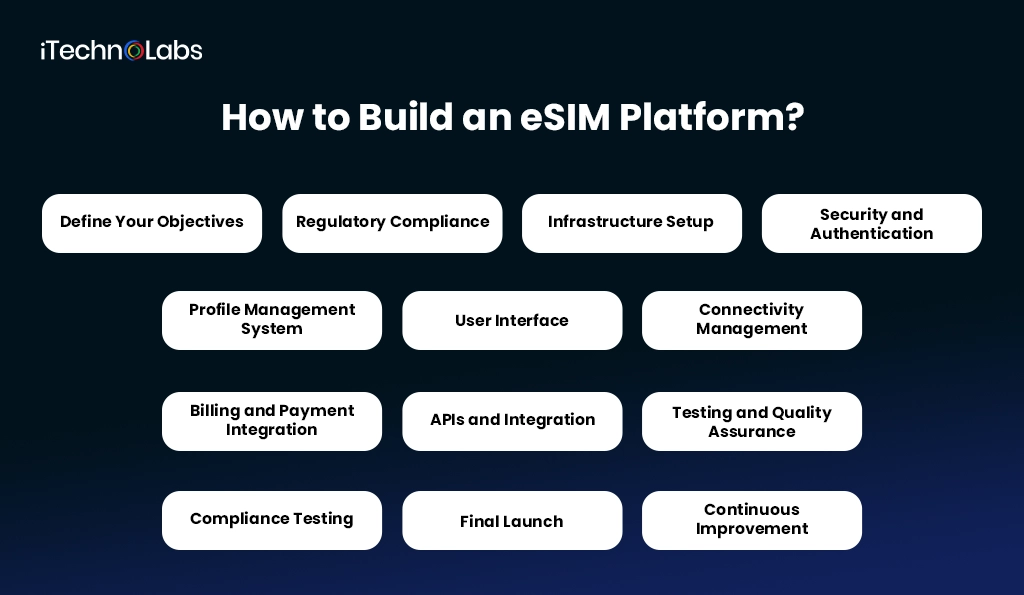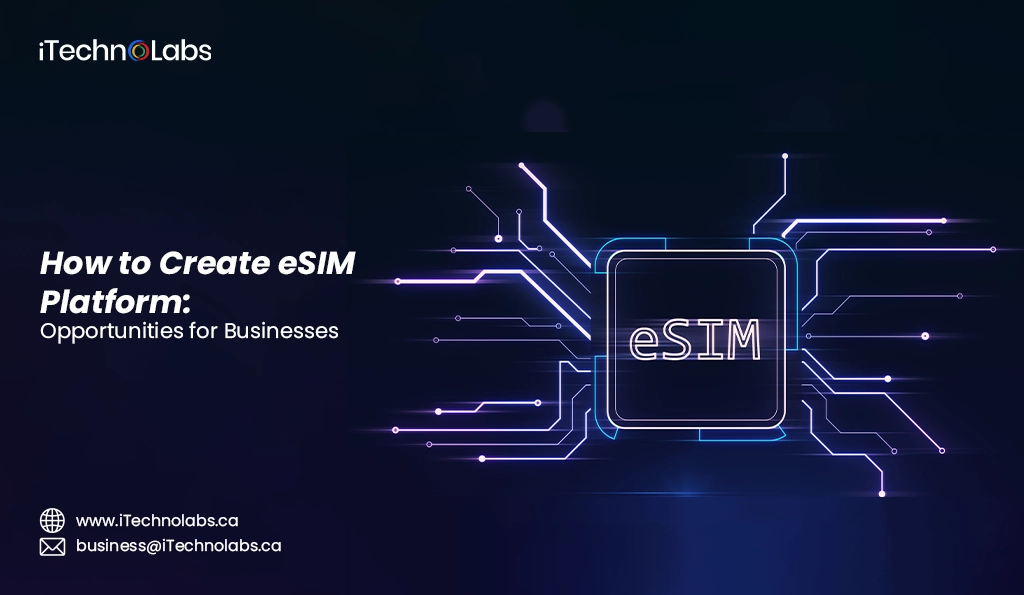The rise of eSIM technology and eSIM platforms has changed the face of telecommunications. eSIMs offer consumers and businesses the comfort of not having to deal with a physical SIM card. For the industry as a whole, the very tangible benefits of eSIM adoption are easier device switching, less reliance on a physical store for a SIM card, and international travel without the local SIM restriction. By now, it is eSIM makers’ task to fathom how to take advantage of this eSIM technology-businesses come into action as eSIM-equipped devices covering smartphones, tablet computers, and smartwatches become popular.
According to GSMA Intelligence, eSIM smartphone connections are projected to reach approximately 850 million globally by 2025 and grow to 6.7 billion by 2030, accounting for 76% of total smartphone connections.
The knowledge about the benefits introduced by eSIMs allows companies to integrate eSIM-based functionalities in services and products so that these companies can give their customers flexible and convenient offerings and explore the options to remain ahead of competition in the ever-changing market.
What is eSIM?
eSIM also stands for “embedded SIM.” An eSIM is a type of SIM card that is already embedded into a device and cannot be readily removed, an example of which is a smartphone. eSIMs also incorporate tablets as well as wearable devices, such as smartwatches. Unlike traditional physical SIMs, which have to be inserted manually, databases can be activated remotely through broadcasters in terms of eSIM, thus eliminating having to physically swap SIM card slots when switching devices or upgrading networks. The process becomes more seamless and easy when dealing with changes among devices and networks.
In addition, this technology can house multiple profiles. Thus, it allows different carrier plans or international numbers to be accessed without physically changing the card by just switching from one profile to another. This is true for both frequent fliers and corporate travelers, who travel from region to region, maintaining different numbers or plans according to what that particular region may warrant.
Also, the benefit that the design will gain is for if it goes for an eSIM, there will be no need for a slot on the device where a SIM card would have been placed. Developers could either use that space or real estate to place components such as larger batteries, better cameras, or extra sensors, leading to well-equipped, advanced devices with added functionality.
The eSIM can also allow better device security and manageability. It is easy, for instance, to disable an eSIM on a lost or stolen handset, thus preventing its use by someone else. In fact, this part of technology is developing very fast, and it’s in the direction of moving ahead with mobile connectivity. Thus, the scenario for a user will be made a lot smoother and more flexible.
Difference Between eSIM vs. Physical SIM Card?

The primary difference between an eSIM and a physical SIM card is the unit. A physical SIM has to be inserted into the SIM card slot on the device. You have to take out a small tray and place the SIM in the tray (thankfully it has a defined area that it has to rest in). An eSIM is ingrained into the hardware of your device during the manufacturing process. It can be activated and provisioned remotely and not physically in the space of a SIM card.
Another significant difference between an eSIM and a physical SIM is an eSIM will allow for multiple profiles to be active concurrently. Your current carrier plan and private or business numbers, or maybe an international number, and you don’t have to change physical SIMs according to which number or plan you wish to use. This is a huge benefit for individuals who frequently travel, have multiple lines to manage, and need to be able to switch, or even just want to avoid carrying multiple physical SIM cards around, and swapping the physical SIMs every time you want to change carriers, numbers, etc.
Physical SIMs will always require the user to manually swap the SIM when needed to change carriers/numbers, and based on the SIM card, changing the SIM card can be a hassle because of its size or speed.
eSIM vs. Physical SIM:
| Feature | eSIM (Embedded SIM) | Physical SIM (Traditional SIM) |
| Form | Built into device | Removable plastic card |
| Switching | Instant, remote | Manual SIM swap |
| Security | More secure, no theft risk | Can be lost or damaged |
| Storage | Multiple carrier profiles | One carrier per SIM |
| Travel | Easy international switching | Requires local SIM or roaming |
| Durability | No wear and tear | Prone to damage |
| Activation | Digital (QR code, app) | Manual insertion |
| Eco Impact | No plastic waste | Creates electronic waste |
| Availability | Limited to supported devices | Works with all phones |
It also makes devices thinner and sleeker. It saves up space in the device by not needing a physical SIM card slot. This space can be used for other components such as larger batteries, better cameras, or even more sensors, which give rise to advanced features and better user experiences. Furthermore, a SIM card slot creates even more durability and water resistance by leaving fewer openings in the device that may allow dust or moisture to enter.
Why are eSIM Platforms in Demand?
First and foremost, out of the numerous reasons responsible for increased eSIM platform demand, the easiest one associated with it is that it’s rather easy to use, operate, and provision from afar. That is possible by doing so in a matter of seconds and in an effortless manner through a carrier’s mobile app or website rather than having to visit a store or handle a physical SIM card.
Growing market demand owing to emerging IoT devices—smartwatches, fitness bands, and connected vehicles—is increasing the demand for smaller and smarter SIM technology. Most of the existing hard-wired SIM cards do not fit in these tiny devices; hence, eSIM comes in as a preferred option.
Another reason that drives effective popularity towards eSIM platforms is potential cost savings for carriers and users alike. eSIMs avoid the issues of physical production, distribution, and activation of SIM cards and thus present clear cost advantages to carriers. Pass these on through lower plans or services to consumers.
Finally, eSIM platforms are also securing enhanced privacy and security for users. The traditional SIM cards run the risk of getting stolen or misplaced, therefore compromising sensitive personal information. The difference is that eSIMs are embedded within the device, so they cannot be stolen or misplaced physically.
Also, read: What is COTS (Commercial-Off-the-Shelf) Software?
How to Build an eSIM Platform?

Creating an eSIM platform requires a deep knowledge of the technology, its possibilities, and the integration with various devices and networks. In general, here are some steps to consider when developing an eSIM platform:
Step 1: Define Your Objectives
Objectives for eSIM platform development should be defined even before talking about development. This objective encompasses target segmentation, market need assessment and preference understanding, and the monetization system for the platform. Furthermore, you also would need to carry out extensive market research in order to understand the competitive landscape as well as to identify potential gaps of opportunity into which the platform could fit. Only if clear objectives and a roadmap for feature development are established can such a platform be developed to satisfy the user demand while being competitive. In addition, regulatory compliance and considerations during implementation will greatly support the survivability of the platform with regard to different device and network compatibility.
Step 2: Regulatory Compliance
When creating an eSIM platform, there are various regulations and standards that you will have to comply with from government and industry organizations. Regulatory institutions will have their jurisprudence or regulations, and those regulations may differ based on where you are going to deploy your eSIM platform. So, it’s important to understand those regulations and comply from the very beginning; for instance, the Federal Communications Commission (‘FCC’), which is the governing body in the United States, has regulations that would cover SIM card technology in the United States, or the European Telecommunications Standards Institute (ETSI) regulations in Europe. Not complying with the existing regulations can result in legal implications and consequences for your business.
Step 3: Infrastructure Setup
Supporting infrastructure is the anatomy of an eSIM platform. The potential presence of servers, databases, and communication channels between users and the platform holds the reality that it is incomplete. Thus, it becomes a much better idea to select a dependable and secure hosting provider while also ensuring that the infrastructure is capable of handling high-volume data traffic. Further on, proper security measures such as encryption and authentication protocols will be crucial to keeping user data private and maintaining trust in both systems and service providers.
Step 4: Security and Authentication
Similar to all other technologies exposing personal data, security and identity management will always be a primary concern, as the eSIM platform contains sensitive, proprietary data. Security strategies against hacks, data breaches, and unauthorized use should include encryption and/or secure storage and regular security audits. Multi-factor identity verification adds a more comprehensive layer of protection against hacking and data breaches. Cybersecurity threats are ever-evolving; awareness and keeping abreast of the latest breaches in security and determining an appropriate ongoing engagement are necessary for performing tasks effectively and efficiently. We need to manage this in relation to previously adopted policies and industry standards. To educate users about security and protecting their own personal information can also be important to a known level of external security.
Step 5: Profile Management System
To be able to efficiently manage the different user profiles for different devices, such an eSIM platform will need a robust profile management system including features for remote provisioning, activation, and deactivation of eSIM profiles-all to facilitate user switching from one carrier or another plan without the physical changing of SIM cards. Furthermore, the profile will enable updates and management of user data and make this secure, ensuring the protection of personal information and compliance with privacy regulations.
Step 6: User Interface
A simple and intuitive user interface is a key factor in the success of an eSIM platform. Users should be able to access their profiles and make changes easily. They should not require any expertise or technical knowledge about eSIMs and should be able to specify and change their plans. This includes using multiple languages and allowing some personalization in the interface. The user interface should be able to provide users with real-time updates and notifications. As service changes that affect the user’s usage, usage-related notifications should allow users to efficiently track and monitor their usage. Both extensive help sections and the ability to contact customer support can further facilitate the user experience by allowing efficient and effective use of the eSIM platform for users of all capabilities.
Step 7: Connectivity Management
In an eSIM platform, it must maintain a high connectivity management capability in order to provide seamless functionality. That means connecting with and maintaining different network operators, enabling flawless data transmission from user devices into networks, and coordinating user authentication for secure access. An efficient connectivity manager can also optimize network usage by smartly selecting the best-preferred network. It can help in reducing roaming charges by migrating users to local networks where possible and allow seamless service where network coverage is intermittent by managing it dynamically. Furthermore, it should also facilitate real-time monitoring and diagnosis to address any issues concerning connectivity beforehand and maintain uninterrupted connectivity services. This whole approach dramatically improves user experience as well as facilitates operational efficiency and cost savings for service providers.
Step 8: Billing and Payment Integration
Because eSIM platforms allow customers to easily switch between networks and plans, the platforms will need to incorporate billing and payment facilities as well. This means that the platform has to be efficient with subsequently recording usage and billing their customers in an accurate way. The platform will need to support multiple payment methods with ease, such as credit/debit cards, mobile wallets, and bank transfers, to make it easy and efficient for their users to pay with a method of their choice. The platform should also provide clear pricing models with live usage updating for customers to monitor their expenditures throughout the month. Not only does this help platform operators with quoting, but it is also a good customer trust feature to let customers see how much they are spending, as more information will streamline overall billing.
Step 9: APIs and Integration
A major plus of eSIM technology is that it is compatible with a variety of devices and networks. An eSIM platform should, therefore, publish good documentation of its APIs in order to minimize integration time with other systems and applications. This way, service providers will be able to utilize the existing infrastructure and fast-track the launch of new services. APIs also enable secure exchange of information among the various stakeholders while permitting adherence to relevant regulations.
Step 10: Testing and Quality Assurance
Before implementing an eSIM platform, comprehensive testing and quality assurance should be performed to verify that the eSIM platform works as intended. Functional testing can be used to test all features as well as measure the performance of the eSIM platform under stress. Security testing can show possible vulnerabilities and threats to the eSIM platform that could be attacked. Compatibility testing can be used to confirm that eSIM will work on whatever device and networks are proposed to be allowed on the eSIM platform. The quality assurance processes will provide good service reliability along with improved service experiences through more confidence that an interruption in service has been minimized.
Step 11: Compliance Testing
As the eSIM technological landscape is continuously progressing, regulatory compliance becomes more critical for service providers. Such compliance testing guarantees that a platform is strictly adhering to the industry standards and regulations, such as GSMA specifications and data protection laws. Not only this, but it also avoids potential legal wrangling, thus building trust with the consumers who have the knowledge that their personal information is secure.
Step 12: Final Launch
Successful testing and compliance checks are conducive to the final implementation of the eSIM platform. This is made up of the configuration of the platform for commercial use and its integration with all related systems and applications. The integrations would include the security of each connection, considerations for device compatibility, and coordination with mobile network operators. There will also need to be thorough training with the customer support teams to prepare for any issues in the future. Launching the platform for the first time is critical for a good user experience; anything going wrong could severely affect customers whose service delivery is related to the eSIM platform. Monitoring and troubleshooting the platform after launch is also important, as it creates opportunities for the platform to be successful and reliable.
Step 13: Continuous Improvement
The introduction of an eSIM platform doesn’t conclude the process of its development. With ever-changing technologies and customer needs, continuous changes can make a product remain in contention to match up with changing demands. Periodic updates and improvements should be injected into the platform as it interacts with users and market trends. Not only will this benefit the customers in terms of user experience, but it will also drive adoption and retention.
Also, read: Advantages and Disadvantages of Computer-Assisted Learning
How much does it cost to build an eSIM platform?
It costs money to spiral up an eSIM platform, just for perspective. Bare minimum implementation—just what you absolutely need—you’re typically in the $100,000 to $250,000 range. The moment you add more heavy-duty security measures, more device support, and actually getting a UI that works together in some fashion, you’re already at over $300,000 and sometimes even as high as $500,000. And that’s simply your initial cost before maintenance and scaling start being an issue.
Constant operations? Yeah, those are going to set your budget back too. Budget of $50,000 to $100,000 a year in maintenance, upgrades, and customer support. Bottom line, you must really do a cost-benefit analysis before you sign that check. If the platform is not going to give you a great ROI, you’re basically just throwing money into a black hole.
- Scope of the Project: The complexity and scale of the project will greatly influence the overall cost. A basic platform will be less costly compared to one with advanced features.
- Desired Features: More features you want, the higher the cost. Important features might include device management, security protocols, user interfaces, and integration with existing systems.
- Technological Infrastructure: The underlying technology stack and infrastructure will also affect the cost. Decisions around cloud services, databases, and other backend services will have financial implications.
- Development Team: The number, skill, and geographical location of the development team may influence the cost substantially. Recruiting local specialists can be more expensive than contracting the work out to other areas.
- Testing and Quality Assurance: It is important that the platform be extensively tested and secure. This includes extra expense for manual and automated testing and security audits.
- Licenses and Compliance: Compliance with industry standards and obtaining necessary licenses and certifications can contribute to cost. These are usually required for legal and operational purposes.
How to Start eSIM Business
Starting an eSIM business requires more than just technical expertise—it demands a clear strategy that aligns with market needs, regulatory standards, and scalable infrastructure to compete effectively in a growing digital ecosystem.
- Market Research: Find your niche—focus on travelers IoT developers, or companies that need global connectivity. Look at competitors and how they price their services.
- Legal Compliance: Get telecom licenses and follow rules like GDPR (EU) or FCC regulations (US). Team up with lawyers to understand local requirements.
- Team Up with MNOs: Work with Mobile Network Operators (MNOs) to use their networks. Talk to them about wholesale data plans you can resell.
- Create Tech Infrastructure: Put money into cloud platforms, eSIM management APIs, and security tools to handle remote SIM setup.
- Sales Plan: Put your efforts into online marketing (SEO, writing social media) and team up with device makers or travel websites.
eSIM Business Model
The eSIM business model unlocks multiple monetization opportunities for both startups and enterprises. By catering to B2B, B2C, and value-added segments, businesses can generate recurring revenue through scalable and flexible solutions.
B2B Solutions:
- Provide connectivity for IoT devices (smart meters, logistics trackers).
- Offer white-label eSIM platforms for telecom resellers.
B2C Models:
- Sell prepaid travel eSIMs via subscription plans or pay-as-you-go bundles.
- Partner with airlines or hotels to bundle eSIMs with bookings.
Value-Added Services:
- Monetize data analytics (e.g., usage patterns for enterprises).
- Charge for API access to your eSIM provisioning system.
Example: Companies like Truphone and Airalo thrive by targeting travelers with affordable, regional data packs.
How to Start an eSIM Company
Starting an eSIM company involves more than just a product idea—it requires laying a solid legal, technical, and operational foundation to ensure regulatory compliance, long-term scalability, and competitive positioning.
- Company Setup: Pick a business structure (LLC corporation) and sign up your firm.
- Permits: Get telecom permits (like MVNO licenses) and stick to GSMA rules for eSIM compatibility.
- Build Your Crew: Bring on board experts in telecom law, software creation, and customer help.
- Backbone: Build or rent a safe eSIM control system. Focus on growth to back more users.
- Grow: Boost ties with carriers, gadget makers, and IoT platforms. Look into joining or buying firms to grow fast
How to Create a Virtual SIM Card
You need to build a safe, software-based stand-in for the old-school SIM. This happens by following global standards using strong coding, and working well with carriers and user screens.
- Implement eUICC Standards: Incorporate GSMA’s Embedded UICC specifications to be device-compatible.
- Design Secure Software: Create an eSIM OS with encryption, secure elements, and OTA (over-the-air) update functionality.
- Integrate with Carriers: Cooperate with MNOs to provide their carrier profiles on your platform.
- Design User Interfaces: Design applications or portals for users to easily activate/manage eSIMs.
- Test Rigorously: Make sure to follow GSMA certifications and carry out beta trials using actual users.
Also, read: Aggregator App Development: An Ultimate Guide 2025
How Businesses Can Earn Revenue by Building an eSIM Platform?
Businesses can earn revenue by building an eSIM platform in several ways. One way is through partnerships with mobile network operators (MNOs) and virtual network operators (MVNOs). By offering their eSIM platform as a service to these carriers, businesses can generate revenue from licensing fees or service charges.
Subscription Fee
Alright, so here’s the deal: companies aren’t shy about grabbing some cash through subscriptions for their eSIM platforms. You know the drill—monthly, yearly, whatever works—just a steady drip of money rolling in. And let’s be real, they love tossing out those tiered plans like candy at a parade. Light user? Here’s a basic plan. Power user? Oh, we’ve got a “premium platinum ultra” tier just for you (with a price tag to match, obviously).
Plus, they’ll dangle some shiny “exclusive” features in front of you—stuff you probably didn’t know you wanted, but now suddenly can’t live without. All of this is designed to keep you locked in and feeling special while your credit card gets cozy with their billing system. It’s not just about pocketing your cash, though. The whole setup keeps you coming back for more, and honestly, if you’re happy and they’re happy, who’s complaining? Well, maybe your bank account.
License Agreement
Here’s the deal: Companies can totally rake in cash by striking up licensing deals with device makers. Think smartphones, tablets, smartwatches—basically anything you can slap an eSIM into. If they get their eSIM baked right into the device before it even hits the shelves, boom, that’s a whole new crowd of users right there. More people, more money, right? Plus, teaming up like this lets them break into fresh markets and snag different kinds of customers. Everybody wants a gadget with eSIM these days, so honestly, it’s a win-win.
Enterprise Plans
You can also target enterprise customers with custom eSIM plans and services. This could be secure and reliable connectivity for IoT devices, smartwatches or company issued smartphones. By customising your eSIM platform to the needs of the enterprise you can generate revenue from licensing fees and service charges and build long term relationships with these customers.
International Roaming Plans
Leveraging eSIM allows international travelers to streamline their roaming experience through a full suite of services. Partnering with a variety of network suppliers in a multitude of countries allows you to deliver frictionless connectivity to your travelers, removing the hassle of physically dealing with SIM cards and giving up valuable travel time to purchase expensive data plans. Overall, not only does this improve customer experience (assuming they enable roaming when they travel internationally), but you can earn passive revenues through roaming fees.
Device Activation Fees
In addition to licensing fees and service charges, businesses can earn money from device activation fees. This applies especially to those offering eSIM platforms for consumer devices like smartphones and wearables. By charging a one-time fee to activate the eSIM on these devices, businesses can create immediate revenue and promote their platform to a wider audience.
Are you planning to hire eSIM platform developers?
Conclusion
By creating a reliable, scalable eSIM infrastructure, businesses can allow themselves to get way out ahead of the curve as eSIM technology continues to change the nature of the IoT and telecoms business. They set the stage for next-gen digital experiences offering dynamic monetisation as well as harmonisation across devices. Preparing for the technical, legal, and commercial dimensions of your eSIM implementation is key, whether you want to focus on international travellers, enterprises or networks of IoT devices.










